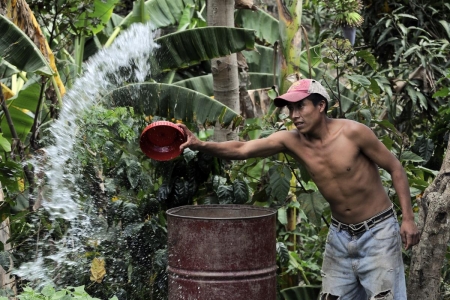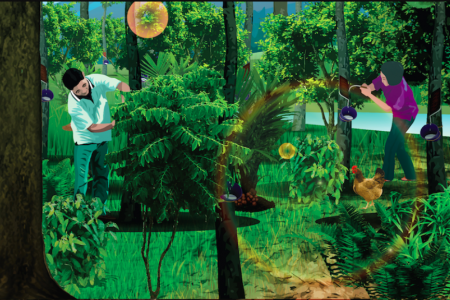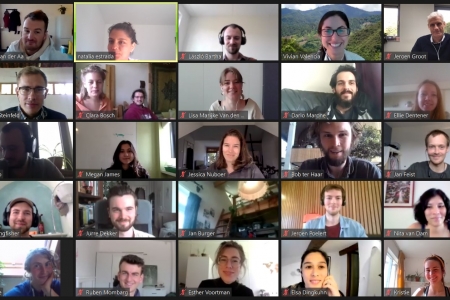By Kris Wyckhuys, Buyung Hadi, Rica Flor, Jonathan Hellin and Wei Zhang.
To tackle today’s planetary-scale challenges of biodiversity loss and chemical pollution, tame solutions and reductionist visions won’t solve the wicked problems of ecosystem management. Instead, to effectively pursue agro-ecological change, Humboldtian perspectives are needed. Humboldt's Naturgemälde, pictured above, may provide a few clues.
Chimborazo—the indestructible, snow-capped “throne of nature,” as Simón Bolívar called the imposing volcano in Ecuador—that’s where a dashing Alexander von Humboldt formulated his vision of nature back in 1802. Having ascended that "stairway of titans" and been granted with “unobstructed vistas” on past and yet-to-be eternities, everything crystalized for the young Humboldt, born 250 years ago last fall. A detailed croquis of the mountain’s cross-section embodied all his thinking—a microcosm on one single page, mirroring how nature is a true web of life, a united whole… a global force. When drawing his “painting of nature” (or Naturgemälde), Humboldt realized how he simply couldn’t just be a geologist or a botanist in order to fully grasp and comprehend all its inter-connections.
“Zapatero a sus zapatos” (cobbler, stick to what you know)—advice often given in monolithic institutions to the occasional scientist who ventures beyond his/her entrenched discipline—certainly wasn’t a call Humboldt heeded. As a true “silo-buster,” his tireless efforts to unite researchers and bridge scientific disciplines are exactly what is needed to solve today’s challenge of feeding a swelling world population, while preserving our resource base and safeguarding biodiversity. Integrative approaches are indispensable to advance sustainable or ecological intensification of the world’s farming systems, and to remediate our current over-reliance on chemical inputs. Over the past five decades both the absolute amount and the toxicity loading of synthetic pesticides has surged—outpacing that of other drivers of global change. Pesticides are now omnipresent, polluting 100% of sampled streams and 83% farm soils in Europe, feathers of 100% of Swiss sparrows, 64-85% of Europe’s marketed apples, lemons and grapefruit and even appear in 100% urine samples of Belgian children. While their farm-level use disrupts vital ecosystem services, can undermine farm profitability and is often superfluous, numerous agro-ecological innovations sit “on the shelf” waiting to be scaled.
The “frustratingly” slow uptake of non-chemical measures such as insect biological control is partially ascribed to an insufficient and inadequate attention to the various technical, socio-economic and policy dimensions that surround farmers’ behavioral change. The resulting “One Health” problems are severe and complex, and need to be addressed by Humboldtians—those who recognize that one simply can’t just be an insect ecologist or a plant pathologist.
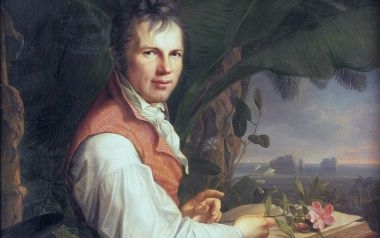
“All Nature’s difference keeps all Nature’s peace,” wrote the English poet Alexander Pope long before Humboldt even initiated his travels. Many farming systems are indeed richly endowed with various forms of life, comprising microbes, companion plants, frogs and lizards, birds, bats and vast numbers of invertebrates. Even the most obscure animals such as ticks occupy a unique niche, and have their own dreaded ”natural enemies”. All the above players interact and actively communicate with wafts of volatiles, sweet gifts of nectar or mesmerizing color displays; and those can’t exclusively be studied in sterile Petri dishes or behind bioinformatics dashboards … by doing so, we snatch in vein at Nature’s veil!
Instead, Humboldt saw nature as dynamic, in flux and thumping with life, an intricate clockwork that needed to be experienced “viscerally”—sleeves rolled up, mud sticking to the booths and pockets filled with rocks. Only such “up-close-and-personal” analysis permits a targeted manipulation of diversity both above and below-ground, and at field, farm and agro-landscape levels, and can ultimately help keep pest populations at bay, improve yield stability and mitigate myriad environmental pressures—including pesticides' carbon footprint or tropical deforestation.
Over time, farmers have come to manipulate pieces of this biodiversity puzzle, as evidenced by the millennia-old practice of weaver ant biological control in China’s citrus orchards. Yet, their increasing reliance upon chemical inputs and quick technology “fixes” can lead to “deskilling”: up to 70% of contemporary farmers are totally unaware of beneficial pest-killing organisms or natural pest control, but do marvel at pesticide-spraying drone armies that take on “monster’ caterpillars. Two-way engagement between scientists and farmers—often facilitated through drawings (though no paintings!) of farm ecosystems—can be an entry-point for validating diversification measures, jointly discovering ecosystem services and valuing their economic benefits at relevant scales of farm operation. Keeping these two worlds tightly linked will prevent a further alienation or rift in human’s metabolic interaction or Stoffwechsel with nature, wrote Karl Marx—another contemporary of Humboldt—150 years ago in Das Kapital.
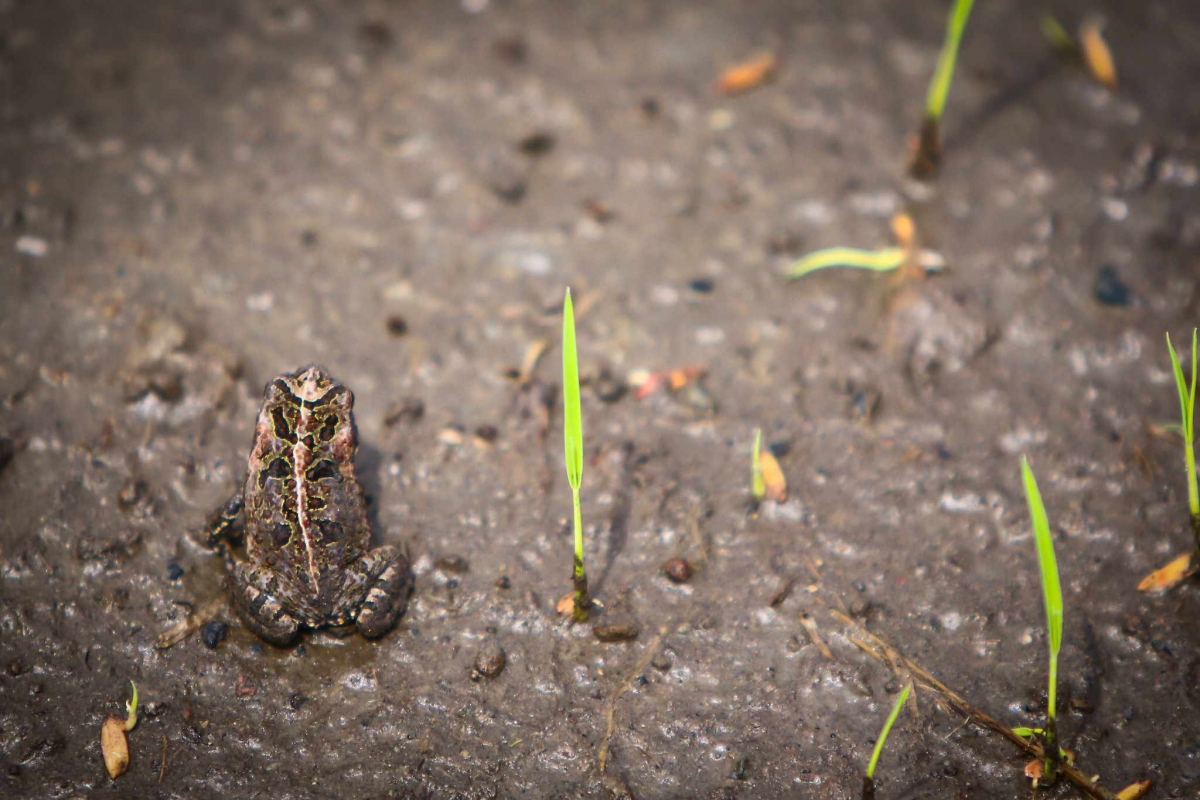
Interdisciplinarity surely is the central pivot. Agronomic decisions though are routinely made in a reductionist fashion, keying in on one part of the system while neglecting others. Overuse of synthetic fertilizer—a practice that was already criticized in the 1800s by Justus von Liebig, “father of the organic chemistry” and Humboldt’s mentee—is often motivated by farmers’ desire to maximize yield. Yet, it can improve plants’ suitability to herbivorous insects, favor pest outbreaks and ultimately trigger insecticide sprays. This in turn harms a variety of beneficial insects and undercuts the cost-free service of biological control. In settings with decayed ecosystem services, particular farming regimes thus easily enforce a “pesticide treadmill”. Those dependencies are further deepened by agro-chemical suppliers, who are influential for both their knowledge and cash loans for chemical inputs, or by national policies that are either unclear or contradictory, ineffective or solely aimed at replacing one chemical input with another. Escaping this 'pesticide lock-in' requires a trans-disciplinary approach that tackles both private—and public-stakeholder relationships, consumer awareness about healthy and pesticide-free farm produce, insurance schemes that ease farmers' transitions towards sound alternatives, outcome-oriented policies to incentivize an active protection of ecosystem services, and a complete overhaul of pesticide regulations.
Ecosystem management is interwoven with a thousand threads, and Humboldt even followed some into the realms of economics. In today's globalized world, on-farm decisions and resulting ecosystem alterations are dictated by volatile shifts in policies, pricing or demand of certain commodities. Globe-spanning trade, as Humboldt, Marx and Liebig all recognized in the 19th century, can easily squander the vitality of the soil, enlarge environmental footprints and aggravate human's “metabolic rift” with nature. On the other hand, agriculture-related damages to the environment and human health are not reflected in the accounting systems of prevailing economic and policy systems, while the stabilizing effects of on-farm biodiversity on commodity markets and global trade or the $300 million-worth fortune ladybugs bring to China's cotton farmers are equally overlooked. All these social and environmental externalities are to be duly inserted into economic systems by evaluating their comprehensive costs and benefits, as recently proposed by UN-Environment.
Insects are at the core of many of today’s sustainable development challenges. They don’t only brighten entomologists’ minds or intrigue world leaders but can equally help build connections—as spokes in a wheel—to other disciplines, thus extending one's reach to new drawers with different colors. If there’s one thing we can learn from Humboldt’s immense legacy, that’s when painting the future of global agriculture and environmental sustainability, our palette surely can’t be monochromatic.
--
Originally published on Nature Ecology & Evolution blog and IFPRI.
Kris Wyckhuys is a bio-science engineer, insect ecologist, and consultant based in Viet Nam; he wrote the main text of this post. Contributors Buyung Hadi, Rica Flor, and Jonathan Hellin work with the International Rice Research Institute (IRRI); Wei Zhang is a Senior Research Fellow with IFPRI’s Environment and Production Technology Division (EPTD). This post first appeared on the Nature Ecology & Evolution blog and IFPRI.




